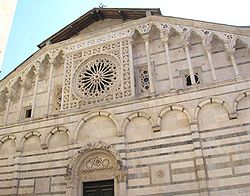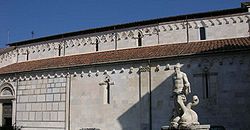
Carrara Cathedral
Encyclopedia


Carrara
Carrara is a city and comune in the province of Massa-Carrara , notable for the white or blue-grey marble quarried there. It is on the Carrione River, some west-northwest of Florence....
, northern Italy
Italy
Italy , officially the Italian Republic languages]] under the European Charter for Regional or Minority Languages. In each of these, Italy's official name is as follows:;;;;;;;;), is a unitary parliamentary republic in South-Central Europe. To the north it borders France, Switzerland, Austria and...
. Nearly all the exterior is covered by local Carrara marble.
History
An older church, Ecclesia Sancti Andree de Carraria, is mentioned as existing on this site as early as 1035, but of it, only a bas-relief remains. The church was enlarged for a first time in 1093, when it received the status of pievePieve
In the Middle Ages, a pieve was a rural church with a baptistery, upon which other churches without baptisteries depended.The Italian word pieve is descended from Latin plebs which, after the expansion of Christianity in Italy, was applied to the community of baptized people...
.
The lower section of the façade and the side area near the St. John Portal are characterized by a bichrome decoration with geometrical marble tarsia
Tarsia
Tarsia is a town and comune in the province of Cosenza in the Calabria region of southern Italy. The ancient town of Caprasia is thought to be the modern Tarsia....
s. This part of the building can be dated to the early 12th century by the influences of the Pisan Gothic style
Gothic architecture
Gothic architecture is a style of architecture that flourished during the high and late medieval period. It evolved from Romanesque architecture and was succeeded by Renaissance architecture....
on the capitals and the architrave
Architrave
An architrave is the lintel or beam that rests on the capitals of the columns. It is an architectural element in Classical architecture.-Classical architecture:...
. This style was also widespread in Liguria at the time, as shown by the similarity of the Cathedral's portal with that of the Genoa Cathedral, finished before 1142. The sculptors of the main portal and of the capitals of the first three spans in the interior belonged to the school of Wiligelmo
Wiligelmo
Wiligelmo was an Italian sculptor, active between c. 1099 and 1120. He was the first sculptor in Italy who started again to produce large size sculptures and signed his work.Wiligelmo was the carver of the Creation and Temptation of Adam and Eve Wiligelmo (also known as Wiligelmus, Gulielmo da...
.
In 1151 the church came under the jurisdiction of the Lateranense Canons of San Frediano of Lucca and the second building phase began, lasting until about 1235 when the apse is known to have existetd. There are similarities of style to contemporary Lucchese architecture. The lateral walls continued without the bichrome decoration. In the interior, the capitals are in Corinthian
Corinthian order
The Corinthian order is one of the three principal classical orders of ancient Greek and Roman architecture. The other two are the Doric and Ionic. When classical architecture was revived during the Renaissance, two more orders were added to the canon, the Tuscan order and the Composite order...
and Composite order
Composite order
The composite order is a mixed order, combining the volutes of the Ionic order capital with the acanthus leaves of the Corinthian order. The composite order volutes are larger, however, and the composite order also has echinus molding with egg-and-dart ornamentation between the volutes...
s, and the mullioned windows have leaves, human and animals motifs, which are perhaps influenced by ancient Roman structures still existing in Lucca at the time.
Overview
The church has a rectangular plan with a semi-circular apseApse
In architecture, the apse is a semicircular recess covered with a hemispherical vault or semi-dome...
.
The façade, finished in the second half of the 14th century, has a bichrome decoration with pale and dark marble stone. The portal is crowned by sculptures inspired to medieval bestiaries
Bestiary
A bestiary, or Bestiarum vocabulum is a compendium of beasts. Bestiaries were made popular in the Middle Ages in illustrated volumes that described various animals, birds and even rocks. The natural history and illustration of each beast was usually accompanied by a moral lesson...
, and surmounted by a Gothic rose window
Rose window
A Rose window is often used as a generic term applied to a circular window, but is especially used for those found in churches of the Gothic architectural style and being divided into segments by stone mullions and tracery...
with twisted columns, each different from the others. The bell tower
Bell tower
A bell tower is a tower which contains one or more bells, or which is designed to hold bells, even if it has none. In the European tradition, such a tower most commonly serves as part of a church and contains church bells. When attached to a city hall or other civic building, especially in...
, standing at 33 m, was also built in the 14th century.
The interior of the Cathedral has a taller nave with wooden truss
Truss
In architecture and structural engineering, a truss is a structure comprising one or more triangular units constructed with straight members whose ends are connected at joints referred to as nodes. External forces and reactions to those forces are considered to act only at the nodes and result in...
es, and two smaller cross-vaulted aisles. It houses the sarcophagus of St. Ceccardus, patron saint of Carrara, a 14th century "Annunciation" (example of Pisan sculpture), and a 14th century wooden crucifix by Angelo Puccinelli.
Outside the church is the "Statua del Gigante" (Statue of the Giant), by Baccio Bandinelli.

